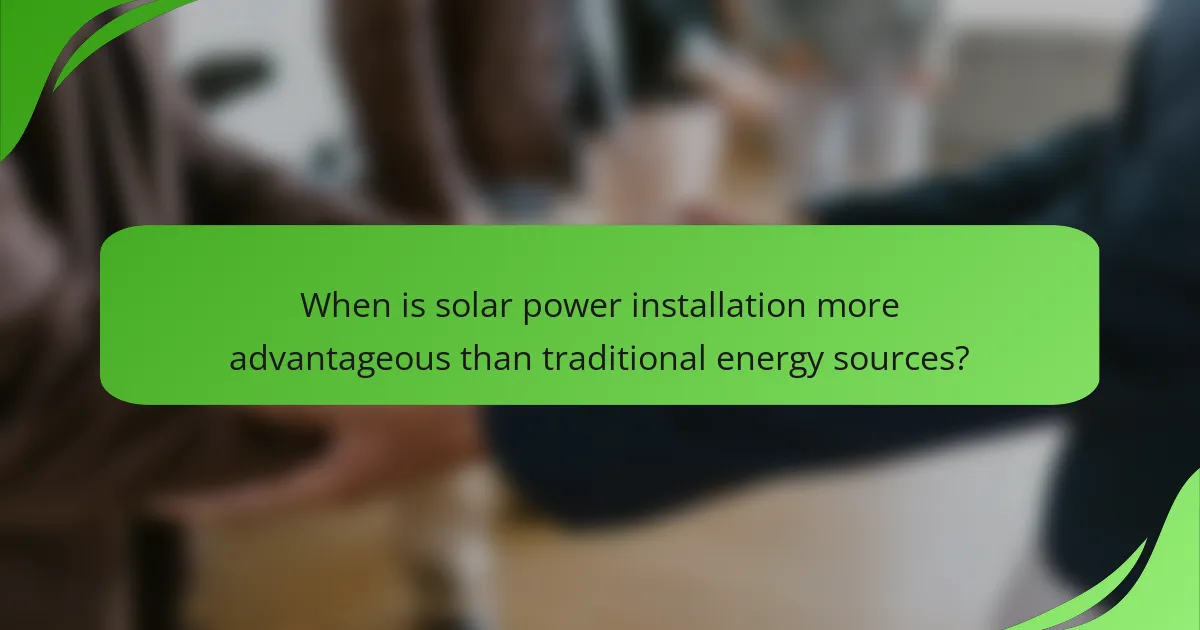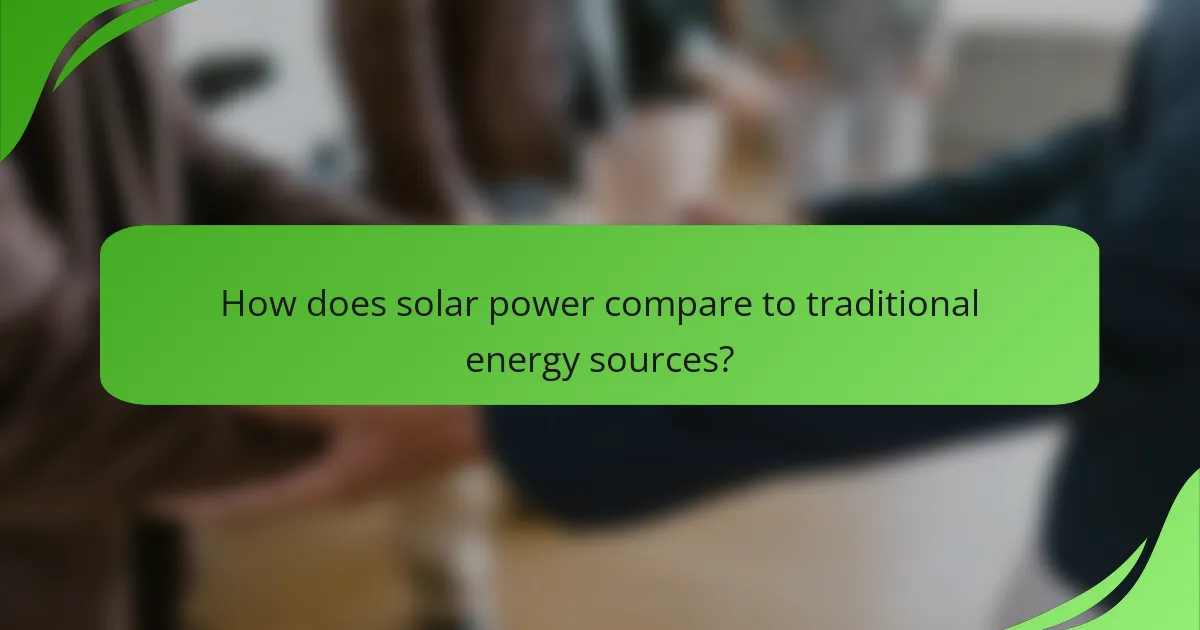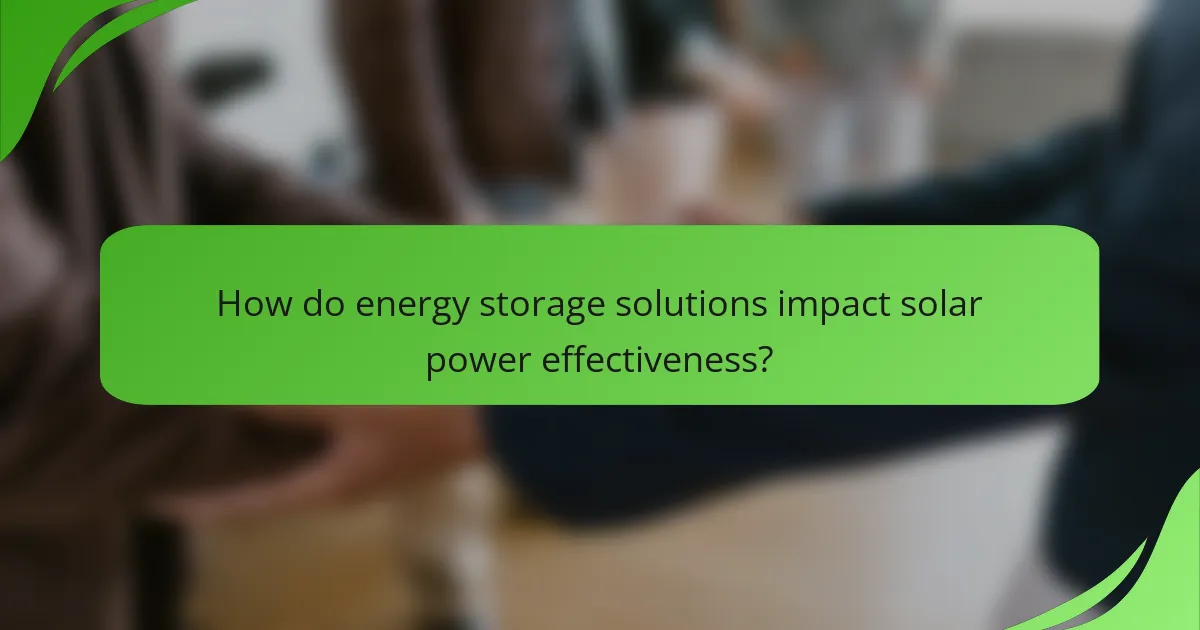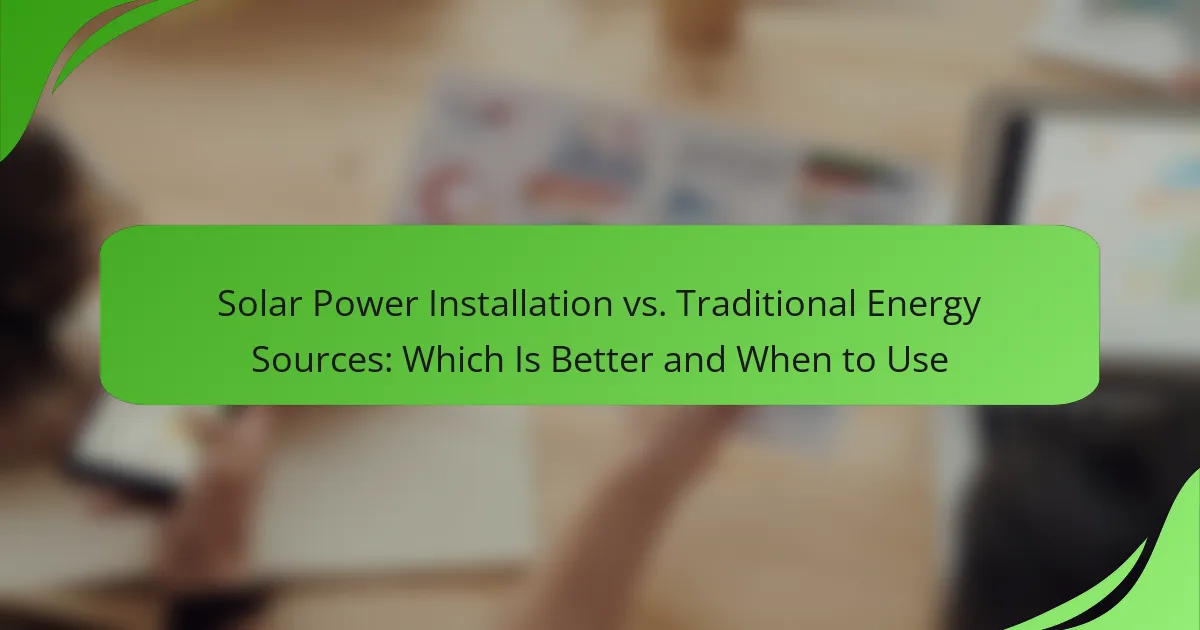As the demand for sustainable energy solutions grows, the comparison between solar power installation and traditional energy sources becomes increasingly relevant. Solar energy offers numerous benefits, such as cost savings and environmental advantages, particularly in sunny regions like California. Understanding when to choose solar over conventional energy sources can help homeowners make informed decisions that align with their financial and ecological goals.

What are the benefits of solar power installation in California?
Solar power installation in California offers significant advantages, including cost savings, environmental benefits, and increased property values. With abundant sunshine, solar energy is a practical choice for homeowners looking to reduce their reliance on traditional energy sources.
Lower energy bills
One of the primary benefits of solar power installation is the potential for lower energy bills. By generating your own electricity, you can significantly reduce or even eliminate your monthly utility costs. In California, homeowners often see savings of 20-50% on their energy bills after installing solar panels.
Additionally, California’s net metering policy allows homeowners to sell excess energy back to the grid, further enhancing savings. This means that during sunny days, when your system produces more energy than you consume, you can receive credits that offset future energy costs.
Environmental impact reduction
Solar power is a clean, renewable energy source that helps reduce greenhouse gas emissions and reliance on fossil fuels. By switching to solar energy, California residents contribute to a decrease in air pollution and combat climate change. This transition is crucial in a state that frequently faces environmental challenges such as wildfires and droughts.
Moreover, solar installations can help preserve natural resources by reducing the demand for non-renewable energy sources. As California aims to achieve its ambitious climate goals, adopting solar energy plays a vital role in promoting sustainability and protecting the environment.
Increased property value
Installing solar panels can enhance your property’s value, making it more attractive to potential buyers. Studies have shown that homes with solar energy systems often sell for more than comparable homes without them. In California, properties with solar installations can see an increase in value ranging from 3-4% or more, depending on the system size and local market conditions.
Furthermore, as energy costs continue to rise, buyers are increasingly looking for homes that offer energy efficiency and lower utility bills. A solar power system not only provides immediate financial benefits but also serves as a long-term investment in your property’s future value.

When is solar power installation more advantageous than traditional energy sources?
Solar power installation is often more beneficial than traditional energy sources when conditions favor high energy generation and cost savings. Factors such as sunlight availability and local electricity prices significantly influence this advantage.
During peak sunlight hours
Solar power systems generate the most electricity during peak sunlight hours, typically between 10 AM and 4 PM. During this time, the efficiency of solar panels is maximized, allowing homeowners and businesses to produce more energy than they consume.
By using solar energy during these hours, users can reduce reliance on grid electricity, leading to lower energy bills. In some regions, net metering policies allow excess energy generated to be sold back to the grid, further enhancing savings.
In areas with high electricity rates
Solar power becomes particularly advantageous in regions where electricity rates are high, often exceeding 0.15 USD per kWh. In such areas, the cost savings from generating your own electricity can be substantial, making solar installation a financially sound investment.
For example, if a household typically pays 200 USD monthly for electricity, switching to solar can drastically reduce this expense. Additionally, many states offer incentives and rebates that can offset the initial installation costs, making solar even more appealing.

What are the costs associated with solar power installation?
The costs associated with solar power installation can vary significantly based on several factors, including system size, location, and installation complexity. Generally, initial expenses can be substantial, but they are often offset by long-term savings on energy bills and potential tax incentives.
Initial installation costs
Initial installation costs for solar power systems typically range from several thousand to tens of thousands of USD, depending on the size and type of the system. For residential installations, prices often fall between $15,000 and $30,000 before any incentives. Factors influencing these costs include the quality of solar panels, inverter types, and installation labor.
Homeowners should also consider additional expenses such as permits, inspections, and potential upgrades to electrical systems. It’s advisable to obtain multiple quotes from certified installers to ensure competitive pricing and quality service.
Long-term savings analysis
Long-term savings from solar power can be significant, often resulting in reduced electricity bills and increased property value. Many homeowners report savings of 50% or more on their energy costs after installation. Depending on local energy prices and available incentives, the payback period for solar systems typically ranges from 5 to 10 years.
Additionally, various tax credits and rebates can further enhance savings. For example, the federal solar tax credit allows homeowners to deduct a percentage of the installation costs from their federal taxes, making solar more financially attractive. Evaluating local utility rates and available incentives is crucial for an accurate savings analysis.

How does solar power compare to traditional energy sources?
Solar power is a renewable energy source that harnesses sunlight, while traditional energy sources like coal, oil, and natural gas are non-renewable. The choice between them depends on factors such as cost, environmental impact, and energy needs.
Renewable vs. non-renewable
Renewable energy sources, like solar, are sustainable and can be replenished naturally. In contrast, non-renewable sources are finite and contribute to environmental degradation through emissions and resource depletion. For instance, solar panels can provide energy for decades with minimal environmental impact, while fossil fuels can lead to significant pollution and climate change.
When considering energy options, evaluate the long-term benefits of renewable sources. While the initial investment for solar installation may be higher, the ongoing savings on energy bills and reduced carbon footprint can make it a more attractive option over time.
Energy efficiency ratings
Energy efficiency ratings help compare the effectiveness of solar power versus traditional energy sources. Solar panels typically have efficiency ratings ranging from 15% to 22%, meaning they convert that percentage of sunlight into usable electricity. Traditional energy sources can vary widely in efficiency, often influenced by the technology used in power plants.
When assessing energy efficiency, consider not only the ratings but also the overall lifecycle impact. Solar installations may require less maintenance and have lower operational costs compared to fossil fuel plants, which often face fluctuating fuel prices and regulatory challenges. Choosing energy sources with higher efficiency ratings can lead to significant savings over time.

What factors influence the decision to choose solar power?
Several key factors influence the decision to choose solar power over traditional energy sources, including local incentives, energy needs, and installation costs. Understanding these elements can help homeowners determine if solar energy is a viable option for their specific situation.
Local incentives and rebates
Local incentives and rebates can significantly reduce the upfront costs of solar power installation. Many states and municipalities offer financial incentives, such as tax credits, grants, or rebates, which can cover a substantial portion of the installation expenses. For example, in the United States, the federal solar tax credit allows homeowners to deduct a percentage of the installation cost from their federal taxes.
Additionally, some utility companies provide rebates for solar installations or offer net metering programs that credit homeowners for excess energy produced. Researching available incentives in your area can help maximize savings and make solar power more affordable.
Homeowner energy needs
Understanding your energy needs is crucial when considering solar power. Homeowners should evaluate their average energy consumption to determine the size of the solar system required. This involves analyzing past utility bills to identify usage patterns and peak demand times.
For instance, a household with high energy consumption may require a larger solar array to meet its needs, while smaller homes or those with energy-efficient appliances might benefit from a more modest system. Consulting with a solar provider can help tailor the installation to match specific energy requirements effectively.

What are the maintenance requirements for solar power systems?
Solar power systems require minimal maintenance compared to traditional energy sources, primarily involving regular cleaning and inspections. Proper upkeep ensures optimal performance and longevity of the system, typically requiring attention every few months or as needed based on environmental conditions.
Regular cleaning and inspections
Regular cleaning of solar panels is essential to remove dirt, dust, and debris that can block sunlight and reduce efficiency. Depending on the location, panels may need cleaning every few months, especially in dusty or pollen-heavy areas. Inspections should be conducted at least once a year to check for any physical damage or wear.
During inspections, look for signs of corrosion, loose wiring, or issues with mounting structures. Keeping records of these inspections can help identify patterns and prevent larger issues down the line.
Inverter replacement timelines
Inverters are crucial components of solar power systems, converting the direct current (DC) generated by the panels into alternating current (AC) for home use. Most inverters have a lifespan of around 5 to 15 years, depending on the type and brand. Regular monitoring can help determine when replacement is necessary.
Signs that an inverter may need replacement include frequent error messages, reduced energy output, or physical damage. Planning for inverter replacement as part of your maintenance schedule can help avoid unexpected costs and ensure continuous energy production.

How do energy storage solutions impact solar power effectiveness?
Energy storage solutions significantly enhance the effectiveness of solar power by allowing for the capture and use of solar energy when it is most needed. They store excess energy generated during sunny periods for use during cloudy days or at night, improving reliability and efficiency.
Types of energy storage systems
Common types of energy storage systems include batteries, pumped hydro storage, and thermal storage. Batteries, particularly lithium-ion, are popular for residential solar setups due to their compact size and efficiency. Pumped hydro storage is more suitable for large-scale applications, utilizing gravitational potential energy to store and release electricity.
Benefits of energy storage for solar power
Energy storage systems provide several benefits for solar power users. They increase energy independence by reducing reliance on the grid, enhance resilience during power outages, and can lower electricity bills by allowing users to store energy during low-cost periods and use it during peak pricing. Additionally, they can help balance supply and demand, contributing to grid stability.
Considerations when choosing energy storage
When selecting an energy storage solution, consider factors such as capacity, discharge rate, lifespan, and cost. The capacity should match your energy needs, while the discharge rate affects how quickly you can access stored energy. Costs can vary widely, so evaluate the total cost of ownership, including installation and maintenance, to find the best fit for your budget.
Common pitfalls in energy storage implementation
Avoid underestimating your energy needs, as this can lead to insufficient storage capacity. Additionally, be cautious of choosing low-quality products that may not perform as expected. It’s also important to consider local regulations and incentives, as these can impact the feasibility and cost-effectiveness of your energy storage solution.
